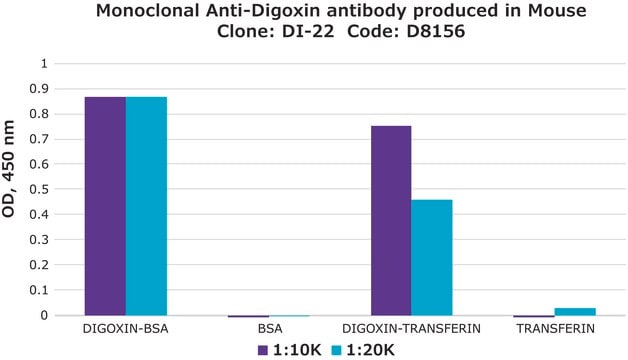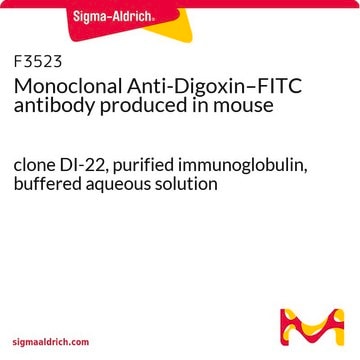11207733910
Roche
Anti-Digoxigenin-POD, Fab fragments
from sheep
Synonyme(s) :
anti-digoxigenin, digoxigenin
About This Item
Produits recommandés
Source biologique
sheep
Niveau de qualité
Conjugué
peroxidase conjugate
Forme d'anticorps
F(ab′)2 fragment of affinity isolated antibody
Type de produit anticorps
primary antibodies
Clone
polyclonal
Forme
lyophilized (clear, brown solution after reconstitution)
Conditionnement
pkg of 150 U
Fabricant/nom de marque
Roche
Température de stockage
2-8°C
Catégories apparentées
Description générale
Spécificité
Application
- Dot blot
- ELISA
- Immunohistocytochemistry
- In situ hybridization
- Western blot
Notes préparatoires
Working concentration: Working concentration of conjugate will depend on the application and substrate. The following concentrations should be taken as a guideline: Dot blot: 150 mU/ml
- ELISA: 50 to 150 mU/ml
- Immunohistocytochemistry: 250 to 500 mU/ml
- In situ hybridization: 1.5 to 7.5 U/ml
- Southern blot: 150 mU/ml
- Western blot: 250 to 500 mU/ml
Working solution: 100 mM Tris-HCl, 150 mM NaCl, pH 7.5.
1% Blocking reagent (w/v), 1 to 5% heat inactivated fetal calf serum (v/v) or sheep normal serum can be used for reduction of unspecific binding.
Reconstitution
Autres remarques
Not finding the right product?
Try our Outil de sélection de produits.
Mention d'avertissement
Warning
Mentions de danger
Conseils de prudence
Classification des risques
Skin Sens. 1
Code de la classe de stockage
11 - Combustible Solids
Classe de danger pour l'eau (WGK)
WGK 1
Point d'éclair (°F)
does not flash
Point d'éclair (°C)
does not flash
Certificats d'analyse (COA)
Recherchez un Certificats d'analyse (COA) en saisissant le numéro de lot du produit. Les numéros de lot figurent sur l'étiquette du produit après les mots "Lot" ou "Batch".
Déjà en possession de ce produit ?
Retrouvez la documentation relative aux produits que vous avez récemment achetés dans la Bibliothèque de documents.
Les clients ont également consulté
Articles
Digoxigenin (DIG) labeling methods and kits for DNA and RNA DIG probes, random primed DNA labeling, nick translation labeling, 5’ and 3’ oligonucleotide end-labeling.
Notre équipe de scientifiques dispose d'une expérience dans tous les secteurs de la recherche, notamment en sciences de la vie, science des matériaux, synthèse chimique, chromatographie, analyse et dans de nombreux autres domaines..
Contacter notre Service technique








